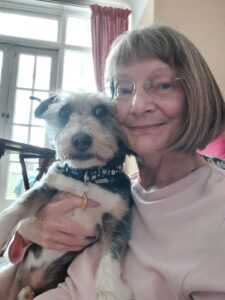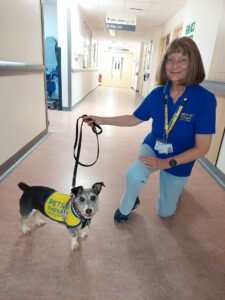
04 Oct 2024
The importance of enjoying life: Rosalyn’s Story
Women in their early 50s who find themselves exhausted and anxious yet unable to sleep often put their symptoms down to menopause. So can their doctors. It took Rosalyn Anderson three years to finally understand what was going on with her body – and to get the devastating news that she had blood cancer.
“When I was 51, I started having repeated colds and respiratory type viruses,” said Rosalyn, 71, who is now retired from her role as a quality manager at Hampshire County Council. “I suffered with severe fatigue, and I became anxious that I was not performing well at work as I used to do. Tiredness zaps self-confidence so anxiety and insomnia set in too. In addition to travelling 60 miles each day to work, I was also caring for my elderly mother at home after she had a stroke. Over a three-year period, multiple trips to see the doctor resulted in being told my symptoms were typical of the menopause, which can reduce immunity, and I was sent home to continue trying to cope, sometimes being offered anti-depressants.”
It was not until 2007 when Rosalyn was 54 that a new GP finally sent her for a full blood count test which led to the diagnosis of chronic lymphocytic leukaemia (CLL).
“This naturally came as a massive shock. I had taken early retirement from work but an earlier accurate diagnosis may have changed that decision. I was fortunate, I now know, that my leukaemia was not an acute type of leukaemia, as delayed diagnosis and the lack of immediate treatment would have allowed disease progression, and I would probably not be here now.
“CLL is typically not treated immediately but patients undergo a ‘watch and wait’ period (or ‘watch and worry’ as a lot of us like to say) with regular blood test monitoring and hospital appointments.”

Rosalyn with her beloved “Pets as Therapy” dog, Digby
For many cancer types, ‘watch and wait’ is a common treatment strategy, particularly in the early stages of the disease. It involves closely monitoring the patient’s condition without immediate intervention, as CLL often progresses slowly and may not cause symptoms for years. This approach is chosen to avoid the side effects of treatment when it is not yet necessary, allowing patients to maintain a good quality of life. Treatment typically begins when the disease shows signs of progression, such as increased lymphocyte counts, worsening symptoms, or organ involvement, indicating that the leukaemia is becoming more aggressive.
“It was not until 2017 when disease progression led to my bone marrow being 96% infiltrated with leukaemia cells that I then received an immuno-chemotherapy treatment over six months called FCR (a combination of chemotherapy drugs called Fludarabine and Cyclophosphamide, and an antibody drug called Rituximab).
“This is a very toxic and gruelling treatment that left my bone marrow much weakened with pancytopenia – low red and white blood cells and platelets – and particularly unable to make enough T-cells which are important for fighting viral infections. I needed five blood transfusions due to anaemia. My blood results were so poor for a long time after treatment that my consultant commented that she hoped I would not develop myelodysplastic syndrome (MDS). This worried me a lot. I also had to self-inject with a drug called G-CSF (granulocyte-colony stimulating factor) for some weeks to try to raise my neutrophil level.
“Throughout my treatment, I was already getting practice in living a restricted life and avoiding crowds. Then, in early 2020, just as my blood results were finally getting back towards a low normal level, along came COVID! That left me trying to balance the desire to do the things I wanted to do against the risks of encountering COVID which, at the time of writing, I have managed to avoid. Fingers crossed!
“When I do attend somewhere that could become busy, I always look to minimise my risk. I take an end of row place at my classes for Pilates and watercolour painting. I do not use public transport. I avoid cinemas and theatres (sadly). If I can, I eat outdoors when meeting friends or go to larger more spacious establishments where possible. I do sometimes feel anxious if I am somewhere and suddenly feel there are too many people around me.
“One risk I have taken is to visit hospitals as a Pets as Therapy volunteer. I rescued my beloved little crossbreed dog Digby from the Dogs Trust in 2021. I lost my previous dog, who’d been with me during my treatment, in 2019 which was devastating. I thought I wouldn’t get another one because of my diagnosis and concerns about his care should my condition worsen. But I’m so glad I did. I knew he would be ideal as a therapy dog as he calms me. We visit rehabilitation wards (since February 2024) rather than patients likely to be ill with infections. I have found this so rewarding.
“During 2022, I volunteered to join Leukaemia UK’s Patient Experience Advisory Panel. I have found this work incredibly interesting especially learning about other people’s experiences with different types of leukaemia. I have also sat on the awards panel for the John Goldman Fellowships and I’m amazed at how much incredible research is going on. More than once, I have felt grateful my disease was not an acute leukaemia.

Rosalyn grew her hair out in order to donate it to children with cancer
“What particularly touched my heart was hearing from the parents of both a baby and a 14-year-old girl who had both lost their fight against leukaemia following late diagnosis. I have since learnt that leukaemia is the most common cancer type among children.
“While it feels a very small gesture to make, I decided to grow my hair in order to donate it to The Little Princess Trust, a charity that makes wigs for children undergoing cancer treatments. I had expected to lose my hair during treatment, but I didn’t. It made me think how awful it must be for those who do.
“I had already started letting my hair grow long because I did not want to visit a hairdresser during COVID, so I was ahead in that sense. I kept measuring the length of my hair in the hope it had grown long enough. But when I checked the charity’s website, I realised they wanted at least 12 inches of hair, so I had to keep going. It took nearly another 18 months until I reached the time for it to be cut.
“At 71, I wondered if I might break a record for being the oldest donor, but no, the charity told me people of all ages donate their hair. Strangely, I felt quite nervous the day I went to the hairdresser. Once done, it then felt satisfying that I had achieved a small challenge on behalf of those children. After I sent the hair off to the charity with a donation, I received a certificate in return, which is really a nice thing to have.
“I do try to enjoy life and not let my leukaemia dictate what I can do too much. I feel very lucky that I have remained in remission. Another thing I’ve done as a result of my diagnosis is become involved with a study at the University of Surrey on the effect of exercise and diet for people with CLL. When I finished chemo, I resolved to improve my fitness, and this project gave me some really good feedback on my health.
“When I was first diagnosed in 2007, I looked at what information was around on treatments and realised there was only one – FCR, which is what I ended up having. It’s a terrible toxic gruelling treatment to go through. But had I been diagnosed now, there are other options and that’s because of research. It’s great to see new first line treatments coming along. I know that, if I relapse, these options are there for me.”

Rosalyn tries to enjoy life and make others’ lives better
Related posts
1 August 2022
A research breakthrough targets cancer over healthy tissue, bringing possibility of a new treatment option for most deadly type of leukaemia
A new scientific paper published on 22nd June in Science Translational Medicine, announced a breakthrough by Leukaemia UK-funded scientist Dr William Grey that could lead to a vital new treatment option for…
17 October 2022
New campaign launches for the forgotten 500,000 families
Patient groups, charities and clinicians unite to raise awareness of half a million vulnerable people, many of whose lives have never returned to normal after the Covid-19 lockdown. A new…
12 December 2022
Widespread coverage of new leukaemia therapy shows promise in first trial patient
As you may have seen in the news over the weekend, a clinical trial investigating a new leukaemia treatment has shown promising results. As part of the trial, funded by…
22 May 2023
Can the unique differences between stem cells tell us how well CML treatment will work?
What if we could predict how chronic myeloid leukaemia (CML) patients will respond to treatment? Could the unique signatures of CML stem cells hold the key to personalising treatment for…